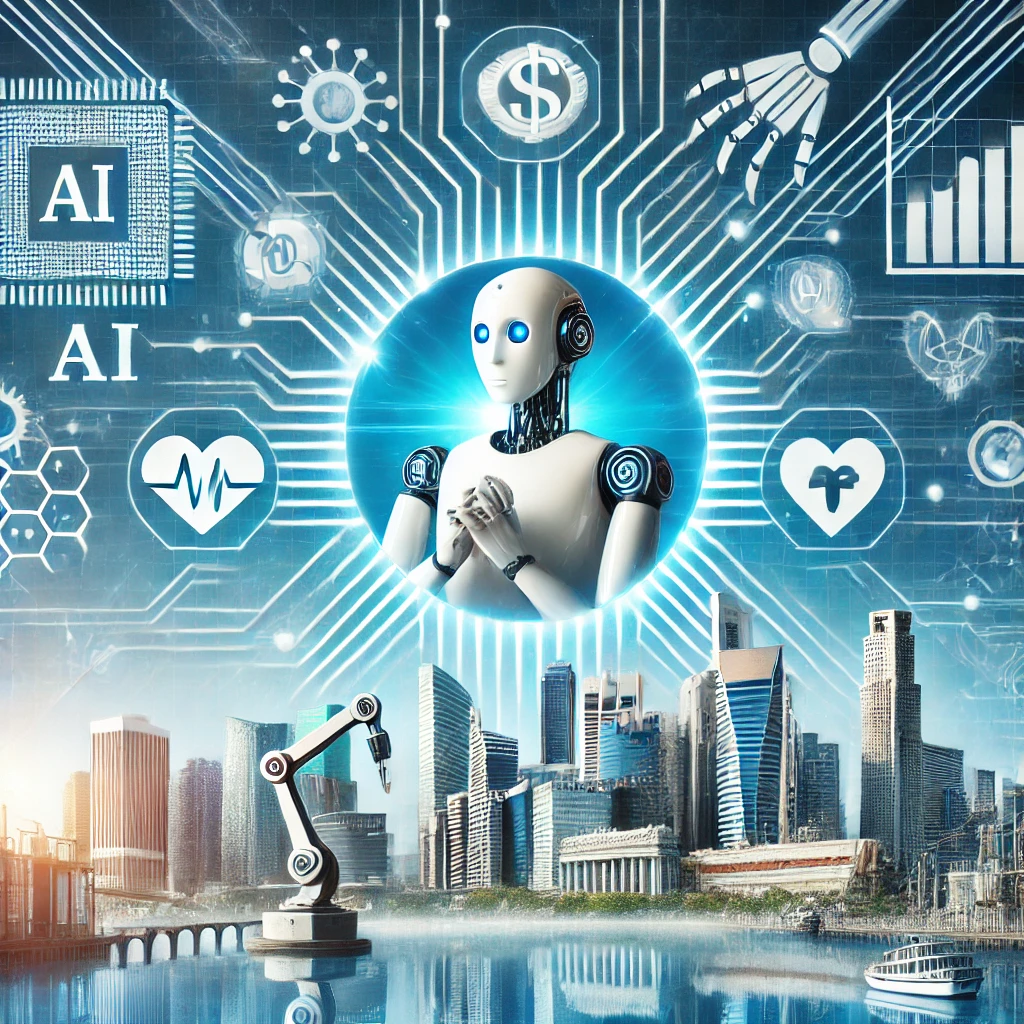Artificial Intelligence (AI) and Machine Learning (ML) have emerged as two of the most transformative technologies of the 21st century. AI refers to the simulation of human intelligence by machines, allowing them to perform tasks that typically require human cognitive functions such as learning, reasoning, problem-solving, and decision-making. Machine Learning, a subset of AI, enables machines to learn from data and improve their performance over time without being explicitly programmed.
AI and ML are driving innovation across industries, from healthcare and finance to entertainment and transportation. This article explores the core concepts, applications, benefits, challenges, and future prospects of AI and ML in detail.
1. What is Artificial Intelligence (AI)?
AI is the development of computer systems capable of performing tasks that traditionally required human intelligence. It involves the use of algorithms and data to enable machines to mimic human thought processes and actions.
Types of AI:
- Narrow AI (Weak AI):
- Designed to perform specific tasks (e.g., Siri, Alexa, spam filters).
- Limited to the task it was trained for.
- General AI (Strong AI):
- Hypothetical form of AI that can perform any intellectual task a human can do.
- Capable of reasoning, problem-solving, and learning from experiences.
- Super AI:
- A future state where AI surpasses human intelligence.
- Capable of outperforming humans in all cognitive tasks.
2. What is Machine Learning (ML)?
Machine Learning is a branch of AI that allows machines to learn and improve from data without explicit programming. ML algorithms identify patterns in data and use them to make predictions or decisions.
Types of Machine Learning:
- Supervised Learning:
- The model is trained on labeled data.
- Example: Spam detection, fraud detection, and image recognition.
- Unsupervised Learning:
- The model is trained on unlabeled data.
- Example: Clustering customer data, market segmentation.
- Reinforcement Learning:
- The model learns through trial and error, receiving rewards for correct actions.
- Example: Game playing (e.g., AlphaGo), robotic control.
3. How AI and ML Work
Key Components:
- Data:
- Large datasets are required to train AI and ML models.
- Data can be structured (e.g., databases) or unstructured (e.g., text, images).
- Algorithms:
- Mathematical formulas and models that process data and identify patterns.
- Common algorithms: Decision trees, neural networks, and support vector machines.
- Training:
- Models are fed with data to learn patterns and improve accuracy.
- The more data the model processes, the better it performs.
- Inference:
- The trained model is used to make predictions or automate tasks.
4. Applications of AI and ML
AI and ML are transforming industries and enabling new capabilities:
a) Healthcare
- Medical diagnosis: AI models can analyze medical images (e.g., X-rays, MRIs) to detect diseases.
- Drug discovery: AI helps in identifying potential drug candidates and predicting side effects.
- Personalized treatment: AI tailors treatment plans based on patient data.
b) Finance
- Fraud detection: Machine learning algorithms identify unusual patterns in financial transactions.
- Algorithmic trading: AI models make real-time trading decisions based on market data.
- Credit scoring: AI evaluates creditworthiness using customer data.
c) Retail and E-commerce
- Recommendation systems: AI suggests products based on browsing and purchase history.
- Inventory management: AI predicts demand and optimizes stock levels.
- Chatbots: AI-powered virtual assistants handle customer inquiries.
d) Transportation
- Autonomous vehicles: Self-driving cars use AI for navigation and obstacle avoidance.
- Traffic management: AI analyzes traffic patterns to reduce congestion.
- Predictive maintenance: AI predicts when vehicle parts will fail.
e) Entertainment
- Content recommendation: Streaming platforms (e.g., Netflix, YouTube) use AI to suggest content.
- Game development: AI creates adaptive gameplay and realistic characters.
- Deepfake technology: AI-generated videos and voice imitations.
f) Manufacturing
- Predictive maintenance: AI monitors equipment health and schedules repairs.
- Quality control: AI identifies defects in production lines.
- Supply chain optimization: AI predicts demand and adjusts production.
5. Benefits of AI and ML
AI and ML offer numerous advantages to businesses and society:
✅ Automation of Repetitive Tasks:
- Reduces human workload and operational costs.
- Increases efficiency and accuracy.
✅ Enhanced Decision-Making:
- AI models analyze large datasets to uncover hidden insights.
- Businesses use AI to make data-driven decisions.
✅ Improved Customer Experience:
- Chatbots and recommendation systems personalize interactions.
- AI-driven support reduces response time.
✅ Increased Innovation:
- AI accelerates research and development.
- Helps create new products and services.
6. Challenges and Limitations of AI and ML
While AI and ML have numerous benefits, they also pose significant challenges:
❌ Bias and Discrimination:
- AI models can inherit biases present in training data.
- Example: Facial recognition systems misidentifying certain ethnic groups.
❌ Data Privacy and Security:
- AI systems require large amounts of data, raising privacy concerns.
- Data breaches and misuse are significant risks.
❌ Job Displacement:
- Automation can lead to job loss in certain industries.
- Reskilling and upskilling the workforce is essential.
❌ High Costs and Complexity:
- Developing AI models requires substantial computational resources.
- Maintaining AI systems is expensive.
7. Ethical Concerns
AI and ML raise several ethical issues that need to be addressed:
- Transparency: AI decision-making processes are often opaque (the “black box” problem).
- Accountability: Who is responsible when AI makes a mistake?
- Manipulation: AI can be used to influence opinions (e.g., deepfakes, targeted ads).
- Surveillance: AI-powered facial recognition can be used for mass surveillance.
8. Future of AI and ML
AI and ML are expected to advance rapidly over the next decade:
🌍 AI in Healthcare:
- AI will enable real-time disease monitoring and early detection.
- Personalized medicine will become more precise and accessible.
🚀 AI in Space Exploration:
- AI will assist in analyzing planetary data and controlling rovers.
- Autonomous spacecraft will explore distant planets.
🧠 Brain-Computer Interfaces:
- Neural interfaces will allow direct communication between brains and machines.
- Potential to restore mobility to paralyzed individuals.
🌐 AI and Global Economy:
AI is expected to contribute $15.7 trillion to the global economy by 2030. Developing nations will benefit from AI-driven agricultural and industrial automation.
| Section | Key Points |
|---|
| Introduction | AI simulates human intelligence; ML enables machines to learn from data and improve performance over time. |
| Types of AI | – Narrow AI – Performs specific tasks (e.g., Siri). – General AI – Hypothetical AI with human-level intelligence. – Super AI – Future AI surpassing human intelligence. |
| Types of Machine Learning | – Supervised Learning – Trained on labeled data. – Unsupervised Learning – Trained on unlabeled data. – Reinforcement Learning – Learns through trial and error. |
| How AI and ML Work | – Data – Large datasets are essential. – Algorithms – Identify patterns and make decisions. – Training – Models improve with more data. – Inference – Using trained models to make predictions. |
| Applications | – Healthcare – Diagnosis, drug discovery, personalized treatment. – Finance – Fraud detection, trading, credit scoring. – Retail – Recommendation systems, inventory management. – Transportation – Autonomous vehicles, traffic control. – Entertainment – Content recommendations, game AI. – Manufacturing – Predictive maintenance, quality control. |
| Benefits | ✅ Automation of tasks ✅ Enhanced decision-making ✅ Improved customer experience ✅ Increased innovation |
| Challenges | ❌ Bias and discrimination ❌ Data privacy and security ❌ Job displacement ❌ High costs and complexity |
| Ethical Concerns | – Transparency – Accountability – Manipulation (e.g., deepfakes) – Surveillance |
| Future of AI and ML | 🌍 Real-time disease monitoring 🚀 AI in space exploration 🧠 Brain-computer interfaces 🌐 $15.7 trillion contribution to global economy by 2030 |
| Conclusion | AI and ML are transforming industries and society, but ethical and technical challenges must be carefully managed for responsible growth. |



